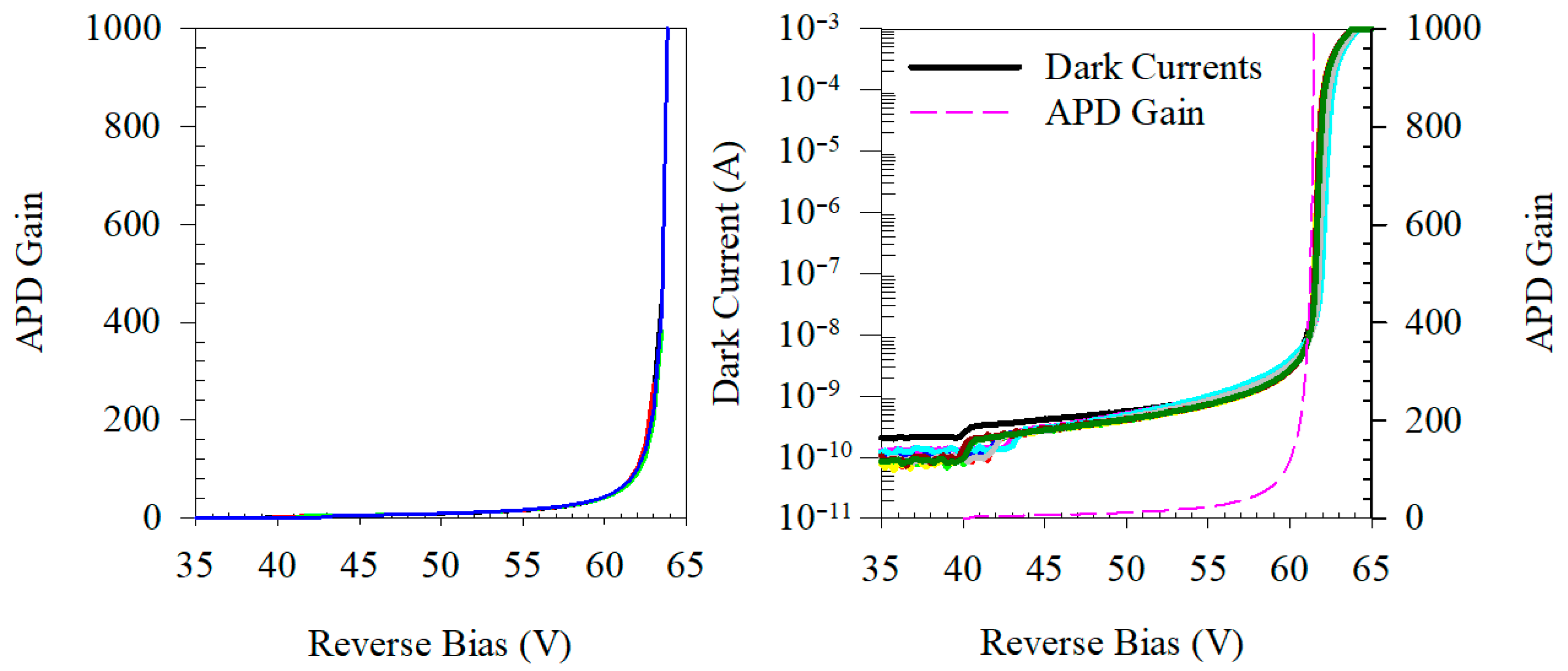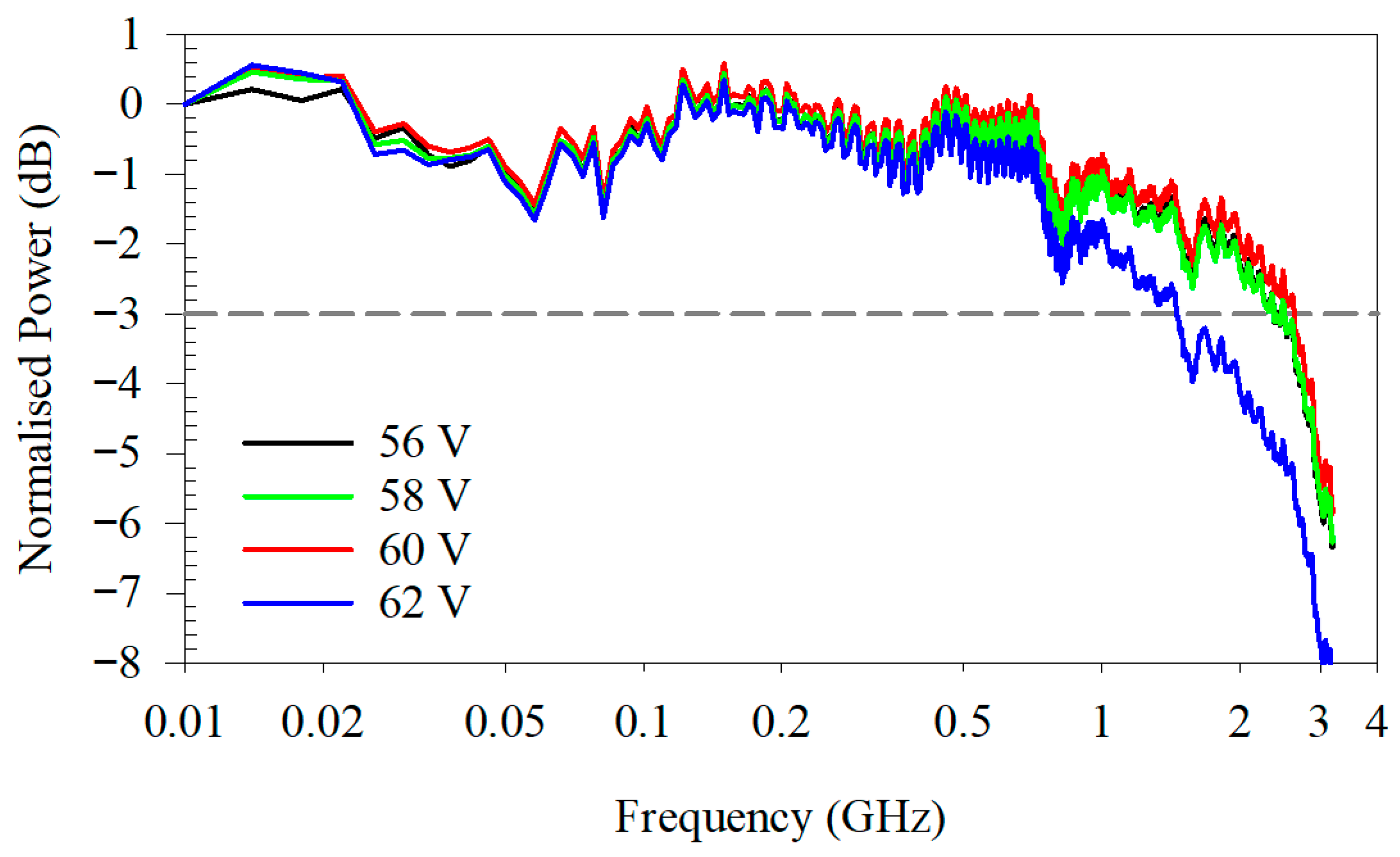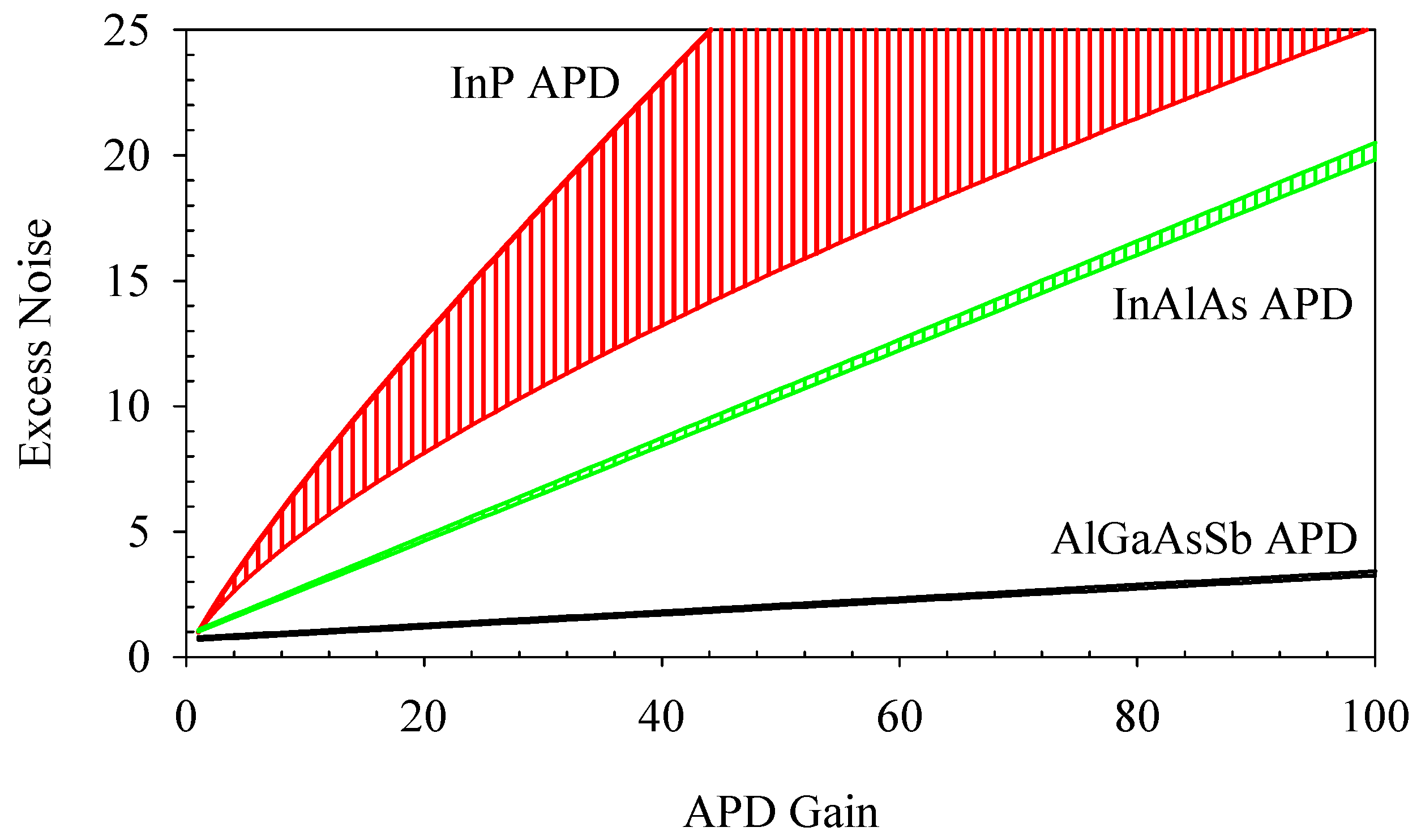Sensitivity Improvement of 2.5 Gb/s Receivers Using AlGaAsSb Avalanche Photodiodes
Abstract
1. Introduction
2. Simulation Model and Results
2.1. BER Model
2.2. APD and TIA Selection
2.3. Atmospheric Link Model
2.4. Simulated Sensitivity at BER = 10−9
3. Experimental Results
3.1. APD-TIA Integration and Receiver Tests
3.2. Experimental Results of Receivers with AlGaAsSb APDs
4. Discussion
- The model assumes an ideal, infinitely large ER, leading to over-optimistic sensitivity values. Using ER = 12 dB (our experimental value), the predicted optimum sensitivity worsens by ~0.5 dB to −41.7 dBm.
- The transmitted optical signal also has an associated intensity noise. From [22], the sensitivity penalty due to intensity noise, ΔPI, can be approximated usingwhere rI is the noise level of the optical signal. The maximum relative intensity noise of our transmitter was −128 dB/Hz, corresponding to an rI value of 3.96 × 10−4 and ΔPI = 0.14 dB. Hence, the optical intensity noise resulted in a minor loss of sensitivity.
- 3.
- 4.
- The model assumes a Gaussian distribution for the amplitude fluctuation of the receiver’s voltage output. This is likely to underestimate the noise contributed by the avalanche gain distribution, which is non-Gaussian [30] and skewed heavily toward gains that are below the mean gain.
- 5.
- The TIA layout necessitated relatively long bond wires between the TIA outputs and the TO-header pins, contributing to parasitic components.
5. Conclusions
Author Contributions
Funding
Institutional Review Board Statement
Informed Consent Statement
Data Availability Statement
Acknowledgments
Conflicts of Interest
Abbreviations
| AlGaAsSb | Aluminum Gallium Arsenide Antimony |
| APD | Avalanche Photodiode |
| BER | Bit Error Rate |
| EPPL | European Preferred Parts List |
| ER | Extinction Ratio |
| FSO(C) | Free-Space Optics (Communication) |
| InAl(Ga)As | Indium Aluminum (Gallium) Arsenide |
| InP | Indium Phosphide |
| ISI | Intersymbol Interference |
| PCB | Printed Circuit Board |
| PRBS-(n) | Pseudorandom Binary Sequence (2n − 1-bit length) |
| TIA | Transimpedance Amplifier |
| TO | Transistor Outline |
References
- Rao, S.; Digge, J.; Rindhe, B.U. Free Space Optics for 5G and Beyond. In Proceedings of the 2021 6th International Conference for Convergence in Technology (I2CT), Maharashtra, India, 2–4 April 2021; pp. 1–5. [Google Scholar] [CrossRef]
- Rockwell, D.; Mercherle, G.S. Wavelength Selection for Optical Wireless Communication Systems. Proc. SPIE 2001, 4530, 27–35. [Google Scholar] [CrossRef]
- Alimi, I.A.; Monteiro, P.P. Revolutionizing Free-Space Optics: A Survey of Enabling Technologies, Challenges, Trends, and Prospects of Beyond 5G Free-Space Optical (FSO) Communication Systems. Sensors 2024, 24, 8036. [Google Scholar] [CrossRef] [PubMed]
- Rabinovich, W.S.; Moore, C.I.; Mahon, R.; Goetz, P.G.; Burris, H.R.; Ferraro, M.S.; Murphy, J.L.; Thomas, L.M.; Gilbreath, G.C.; Vilcheck, M.; et al. Free-Space Optical Communications Research and Demonstrations at the US Naval Research Laboratory. Appl. Opt. 2015, 54, F189. [Google Scholar] [CrossRef] [PubMed]
- Li, B.; Guo, M.; Wang, Y.; Lu, Z.; Xu, D.; Yao, Y.; Zhang, H.; Liu, B. Long-Range Free-Space Inter-Island Optical Communications in Offshore Surface Environment. Opt. Eng. 2025, 64, 058107. [Google Scholar] [CrossRef]
- Shafi, F.; Kumar, A.; Nakkeeran, R. 2024 Performance Analysis of Free Space Optical Networks Under External Limiting Factors. Results Opt. 2004, 14, 100615. [Google Scholar] [CrossRef]
- Szajowski, P.F.; Nykolak, G.; Auborn, J.J.; Presby, H.M.; Tourgee, G.E.; Korevaar, E.J.; Schuster, J.J.; Kim, I.I. 2.4 km Free-Space Optical Communication 1550 nm Transmission Link Operating at 2.5 Gb/s—Experimental Results. In Proceedings of the Optical Wireless Communicationss, Boston, MA, USA, 27 January 1999; Volume 3532. [Google Scholar] [CrossRef]
- Ong, D.S.; Ng, J.S.; Hayat, M.M.; Sun, P.; David, J.P.R. Optimization of InP APDs for High-Speed Lightwave Systems. J. Lightw. Technol. 2009, 27, 3294–3302. [Google Scholar] [CrossRef]
- Dexerials InGaAs APD-TIA Receivers KPDXA2GK-H33. Available online: https://www.dexerials.jp/asset/optical_semiconductor/products/kpdxa2gk-h33/kpdxa2gk-h33_en.pdf (accessed on 10 October 2025).
- GoFoton InGaAs Avalanche Photodiode (APD) 2.5 Gbps APD with TIA. Available online: http://gofoton.cn/products/optics/materials/apd_tia.html (accessed on 10 October 2025).
- Ferraro, M.S.; Singh, A.; Tern, Z.T.; Murphy, J.L.; Mahon, R.; Rabinovich, W.S.; Krejca, B.D. 2.5G large area avalanche photodiodes for free space optical communication. In Proceedings of the Free-Space Laser Comms, San Francisco, CA, USA, 30–31 January 2024; Volume XXXVII, p. 1335525. [Google Scholar] [CrossRef]
- Ge, H.; Liang, Y.; Wang, W.; Wang, Z.; Zhu, L.; Huang, J.; Wang, G.; Wu, D.; Xu, Y.; Niu, Z.; et al. Low Noise Low Dark Current AlAsSb/GaAsSb Digital Alloy Avalanche Photodiode. Opt. Express 2025, 33, 10591. [Google Scholar] [CrossRef] [PubMed]
- Guo, B.; Schwartz, M.; Kodati, S.H.; McNicholas, K.M.; Jung, H.; Lee, S.; Konowitch, J.; Chen, D.; Bai, J.; Guo, X.; et al. InGaAs/AlInAsSb avalanche photodiodes with low noise and strong temperature stability. APL Photon. 2023, 8, 116112. [Google Scholar] [CrossRef]
- Yi, X.; Xie, S.; Liang, B.; Lim, L.W.; Cheong, J.S.; Debnath, M.C.; Huffaker, D.L.; Tan, C.H.; David, J.P.R. Extremely low excess noise and high sensitivity AlAs0.56Sb0.44 avalanche photodiodes. Nat. Photon. 2019, 13, 683–686. [Google Scholar] [CrossRef]
- Taylor-Mew, J.D.; Petticrew, J.D.; Tan, C.H.; Ng, J.S. Simulation of Al0.85Ga0.15As0.56Sb0.44 avalanche photodiodes. Opt. Express. 2022, 30, 17946. [Google Scholar] [CrossRef] [PubMed]
- Lee, S.; Guo, B.; Kodati, S.H.; Jung, H.; Schwartz, M.; Jones, A.H.; Winslow, M.; Grein, C.H.; Ronningen, T.J.; Campbell, J.C.; et al. Random Alloy Thick AlGaAsSb Avalanche Photodiodes on InP Substrates. Appl. Phys. Lett. 2022, 120, 071101. [Google Scholar] [CrossRef]
- Jung, H.; Lee, S.; Jin, X.; Liu, Y.; Ronningen, T.J.; Grein, C.H.; David, J.P.R.; Krishna, S. Low Excess Noise and High Quantum Efficiency Avalanche Photodiodes for beyond 2 Μm Wavelength Detection. Commun Mater 2024, 5, 219. [Google Scholar] [CrossRef]
- Sheridan, B.; Xiao, C.; Taylor-Mew, J.D.; White, B.; Ng, J.S.; Tan, C.H. An Extremely Low Noise-Equivalent Power Photoreceiver Using High-Gain InGaAs/AlGaAsSb APDs. J. Lightw. Technol. 2024, 43, 741–746. [Google Scholar] [CrossRef]
- Hamamatsu InGaAs APD G8931 Series. Available online: https://www.hamamatsu.com/content/dam/hamamatsu-photonics/sites/documents/99_SALES_LIBRARY/ssd/g8931_series_kapd1018e.pdf (accessed on 10 October 2025).
- Xiang, W.; Zhang, S.; Chen, C.; Wu, J.; Ding, Y.; Wang, K. AlGaAsSb APDs for 1550nm Lidar with High Sensitivity and Reliability. In Proceedings of the 50th European Conference on Optical Communication, ECOC 2024, Frankfurt, Germany, 22–26 September 2024; pp. 1960–1963. [Google Scholar]
- ESA Specification for Terabit/Sec Optical Links (ESTOL). Available online: https://connectivity.esa.int/sites/default/files/2025-07/ESTOL_air_interface_v2.2.pdf (accessed on 10 October 2025).
- Agrawal, G.P. Fibre-Optic Communication Systems, 4th ed.; John Wiley & Sons: Hoboken, NJ, USA, 2010; pp. 162–165. ISBN 987-0-470-50511-3. [Google Scholar]
- Nada, M.; Yoshimatsu, T.; Nakajima, F.; Sano, K.; Matsuzaki, H. A 42-GHz Bandwidth Avalanche Photodiodes Based on III-V Compounds for 106-Gbit/s PAM4 Applications. J. Light. Technol. 2019, 37, 260–265. [Google Scholar] [CrossRef]
- HiLight Semiconductor Datasheet: HLR2G50. Available online: https://www.hilight-semi.com/wp-content/uploads/HLR2G50-WebBrief.pdf (accessed on 10 October 2025).
- Ommic Product Datasheet CGY2102UH/C2 2.5 Gb/s Transimpedance Amplifier. Available online: https://fregat.ru/upload/iblock/675/x59np4x81gnfa8d1csrix3sqcuvzjxpd.pdf (accessed on 10 October 2025).
- Phyworks PHY1097-03 2.5 Gbps High Sensitivity Transimpedance Amplifier. Available online: https://www.analog.com/media/en/technical-documentation/data-sheets/phy1097.pdf (accessed on 10 October 2025).
- Kim, I.I.; McArthur, B.; Korevaar, E.J. Comparison of laser beam propagation at 785 nm and 1550 nm in fog and haze for optical wireless communications. In Proceedings of the Optical Wireless Communications, Boston, MA, USA, 6 February 2001; Volume III. [Google Scholar] [CrossRef]
- World Meteorological Organization (WMO). Guide to Instruments and Methods of Observation, 2024th ed.; WMO: Geneva, Switzerland, 2025; p. 352. [Google Scholar] [CrossRef]
- Saleh, B.E.A.; Hayat, M.M.; Teich, M.C. Effect of Dead Space on the Excess Noise Factor and Time Response of Avalanche Photodiodes. IEEE Trans. Electron Devices 1990, 37, 1976–1984. [Google Scholar] [CrossRef]
- McIntyre, R.J. The distribution of gains in uniformly multiplying avalanche photodiodes: Theory. IEEE Trans. Electron Devices 1972, 19, 703–713. [Google Scholar] [CrossRef]






| Receiver | Sensitivity (dBm) @ BER | (A/W) |
|---|---|---|
| Dexerials [9] | −35.0 @ 10−9 | 0.95 |
| GoFoton [10] | −34.7 @ 10−9 | n/a |
| InGaAs/InAlAs [11] | −38.8 @ 10−9 * | 1.02 |
| Avalanche Material | F at M = 50 | (A/W) | Diameter (µm) | Id (nA) |
|---|---|---|---|---|
| AlGaAsSb | 2.03 ± 0.06 | 0.95 | 50 | 0.05 |
| InP | 15.46 to 27.81 | 0.80 to 0.90 | 40 | 4.0 |
| InAlAs | 10.51 ± 0.18 | 1.025 | 100 | 0.045 |
| TIA | Brec (GHz) | Noise Current (nA) |
|---|---|---|
| HiLight HLR2G50 | 1.8 | 200 |
| Ommic CGY2102UH/C2 | 2.5 to 2.8 | 207 |
| Phyworks PHY1097-03 | 1.866 | 150 to 200 |
| Parameter | PTX | dTX and dRX | ϴ | LC and LP | LM |
|---|---|---|---|---|---|
| Value | 10 dBm | 10 cm | 2 mrad | 1 dB | 5 dB |
| APD | TIA | Upper | Typical | Lower | |||
|---|---|---|---|---|---|---|---|
| Mopt | S. (dBm) | Mopt | S. (dBm) | Mopt | S. (dBm) | ||
| AlGaAsSb | HLR2G50 | 66 | −43.3 | 66 | −43.4 | 67 | −43.5 |
| CGY2102UH/C2 | 54 | −42.1 | 54 | −42.2 | 58 | −42.6 | |
| PHY1097-03 | 65 | −43.2 | 56 | −43.8 | 57 | −43.9 | |
| InP | HLR2G50 | 14 | −36.3 | 19 | −37.8 | 19 | −37.8 |
| CGY2102UH/C2 | 11 | −35.2 | 15 | −36.6 | 16 | −36.9 | |
| PHY1097-03 | 13 | −36.2 | 15 | −38.2 | 15 | −38.2 | |
| InAlAs | PHY1097-03 | 24 | −39.7 | 21 | −40.3 | 21 | −40.3 |
Disclaimer/Publisher’s Note: The statements, opinions and data contained in all publications are solely those of the individual author(s) and contributor(s) and not of MDPI and/or the editor(s). MDPI and/or the editor(s) disclaim responsibility for any injury to people or property resulting from any ideas, methods, instructions or products referred to in the content. |
© 2025 by the authors. Licensee MDPI, Basel, Switzerland. This article is an open access article distributed under the terms and conditions of the Creative Commons Attribution (CC BY) license (https://creativecommons.org/licenses/by/4.0/).
Share and Cite
Veitch, J.; Chen, D.; Petticrew, J.; Ng, J.S.; Tan, C.H. Sensitivity Improvement of 2.5 Gb/s Receivers Using AlGaAsSb Avalanche Photodiodes. Appl. Sci. 2025, 15, 12056. https://doi.org/10.3390/app152212056
Veitch J, Chen D, Petticrew J, Ng JS, Tan CH. Sensitivity Improvement of 2.5 Gb/s Receivers Using AlGaAsSb Avalanche Photodiodes. Applied Sciences. 2025; 15(22):12056. https://doi.org/10.3390/app152212056
Chicago/Turabian StyleVeitch, Jonty, Ding Chen, Jonathan Petticrew, Jo Shien Ng, and Chee Hing Tan. 2025. "Sensitivity Improvement of 2.5 Gb/s Receivers Using AlGaAsSb Avalanche Photodiodes" Applied Sciences 15, no. 22: 12056. https://doi.org/10.3390/app152212056
APA StyleVeitch, J., Chen, D., Petticrew, J., Ng, J. S., & Tan, C. H. (2025). Sensitivity Improvement of 2.5 Gb/s Receivers Using AlGaAsSb Avalanche Photodiodes. Applied Sciences, 15(22), 12056. https://doi.org/10.3390/app152212056







